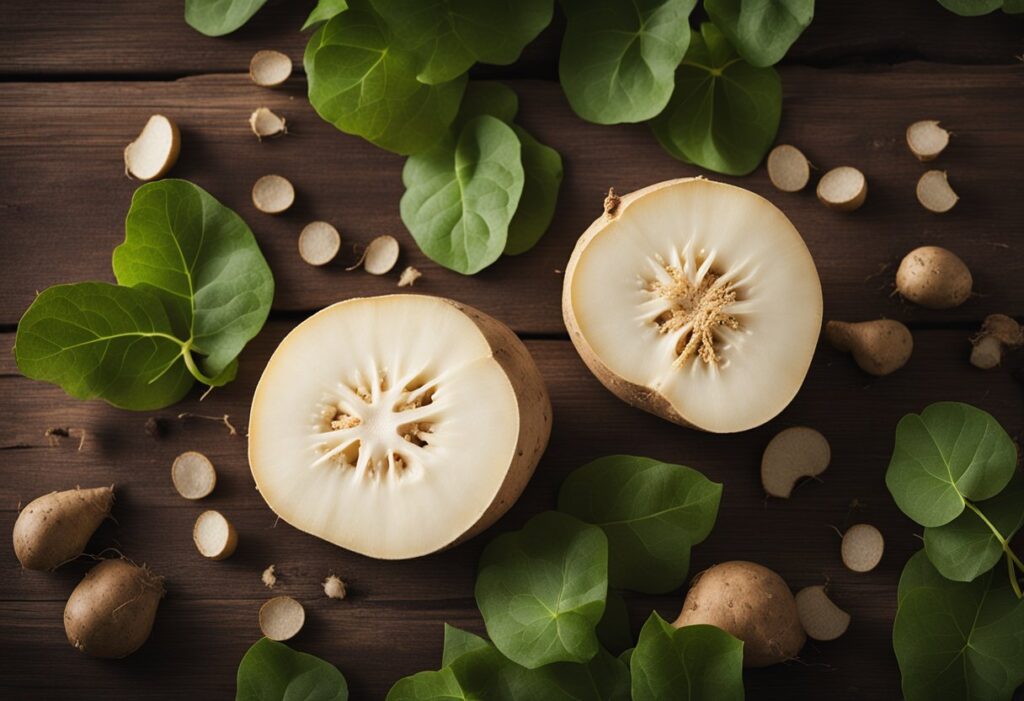White sweet potato are a delicious and nutritious vegetable that has been gaining popularity in recent years. Unlike their orange counterparts, white sweet potatoes have a slightly sweet and nutty flavor that pairs well with a variety of dishes. They are also packed with vitamins, minerals, and fiber, making them a healthy addition to any diet.

One of the main benefits of white sweet potatoes is their high nutritional content. They are an excellent source of vitamin C, which is essential for immune function and skin health. They also contain significant amounts of vitamin B6, potassium, and dietary fiber, all of which are important for maintaining overall health and well-being. Additionally, white sweet potatoes are a low glycemic index food, meaning they release sugar into the bloodstream slowly and can help regulate blood sugar levels.
Overall, white sweet potatoes are a versatile and healthy vegetable that can be enjoyed in a variety of ways. Whether roasted, mashed, or baked, they are a delicious addition to any meal. With their unique flavor and impressive nutritional profile, it’s no wonder that more and more people are discovering the benefits of this tasty root vegetable.
Nutritional Profile
Macronutrients
White sweet potatoes are a good source of carbohydrates, providing approximately 26 grams per 100-gram serving. They are also relatively low in fat, with only about 0.1 grams per serving. Additionally, they contain a moderate amount of protein, with approximately 1.5 grams per serving.
Vitamins and Minerals
White sweet potatoes are rich in vitamins and minerals, including vitamin C, vitamin B6, potassium, and manganese. One 100-gram serving of white sweet potato provides approximately 22% of the daily recommended intake of vitamin C, which is essential for immune system function and collagen synthesis. Vitamin B6 is important for brain development and function, and a serving of white sweet potato provides approximately 10% of the daily recommended intake. Potassium is important for regulating blood pressure and heart function, and a serving of white sweet potato provides approximately 10% of the daily recommended intake. Manganese is important for bone health and wound healing, and a serving of white sweet potato provides approximately 12% of the daily recommended intake.
Dietary Fiber Content
White sweet potatoes are a good source of dietary fiber, providing approximately 3 grams per 100-gram serving. Dietary fiber is important for maintaining digestive health and regulating blood sugar levels. It can also help with weight management by promoting feelings of fullness.
Overall, white sweet potatoes are a nutritious and delicious addition to any diet. They are a good source of carbohydrates, vitamins, minerals, and dietary fiber, making them a great choice for anyone looking to improve their overall health and wellbeing.
Cultivation

Growing Conditions
White sweet potatoes require specific growing conditions to thrive. They grow best in warm, humid climates with a temperature range of 75-85°F (24-29°C). The soil should be well-drained, loose, and rich in organic matter. The pH level of the soil should be between 5.0 and 6.5 for optimal growth.
It is important to note that white sweet potatoes are sensitive to frost and should not be planted until the soil temperature has reached at least 60°F (16°C). They also require plenty of sunlight, so it is best to plant them in an area that receives at least 6 hours of direct sunlight per day.
Harvesting Techniques
White sweet potatoes are typically ready for harvest 90-120 days after planting. To harvest, gently dig around the base of the plant with a garden fork and carefully lift the potatoes out of the ground. Be sure to handle them gently to avoid bruising or damaging the skin.
After harvesting, it is important to cure the sweet potatoes for 1-2 weeks in a warm, humid environment. This allows the skin to harden and the sugars to develop, resulting in a sweeter flavor. Once cured, store the sweet potatoes in a cool, dark place with a temperature range of 55-60°F (13-16°C) and high humidity to prevent moisture loss.
Overall, with the proper growing conditions and harvesting techniques, white sweet potatoes can be a delicious and nutritious addition to any garden.
Culinary Uses

Traditional Recipes
White sweet potato has been a staple food in many cultures for centuries. In traditional recipes, it is often boiled or roasted and served as a side dish. It can also be mashed and used in stews, soups, and casseroles. In some cultures, it is even used to make desserts such as sweet potato pie.
In Japanese cuisine, white sweet potato is often used in savory dishes such as tempura or as a filling for dumplings. In Korean cuisine, it is used to make a popular snack called mattang, which is made by coating the sweet potato in a sweet syrup and then frying it.
Modern Preparations
In recent years, white sweet potato has become a popular ingredient in modern cuisine. It is often used as a substitute for regular potatoes in dishes such as fries, chips, and mashed potatoes. It can also be used in salads, smoothies, and baked goods.
One popular modern preparation is sweet potato toast, where the sweet potato is sliced and toasted like bread. It can be topped with a variety of toppings such as avocado, eggs, or nut butter.
Another popular modern preparation is sweet potato noodles, which are made by spiralizing the sweet potato and using it as a gluten-free alternative to regular pasta. It can be served with a variety of sauces and toppings.
Overall, white sweet potato is a versatile and nutritious ingredient that can be used in a variety of traditional and modern recipes. Its mild flavor and slightly sweet taste make it a great addition to any dish.
Health Benefits
White sweet potatoes are a nutritious and delicious addition to any diet. They are loaded with vitamins, minerals, and antioxidants that provide numerous health benefits. Here are some of the key health benefits of white sweet potatoes:
Blood Sugar Regulation
White sweet potatoes have a low glycemic index, which means they release sugar into the bloodstream slowly, providing a steady source of energy and preventing spikes in blood sugar levels. This makes them an excellent food choice for people with diabetes or those looking to maintain stable blood sugar levels.
Digestive Health
White sweet potatoes are a good source of dietary fiber, which is essential for maintaining digestive health. Fiber helps to promote regular bowel movements, prevent constipation, and reduce the risk of colon cancer. Additionally, the fiber in white sweet potatoes can help to promote feelings of fullness, which can aid in weight management.
Antioxidant Properties
White sweet potatoes are rich in antioxidants, which are compounds that help to protect the body against damage from harmful free radicals. Antioxidants can help to reduce inflammation, prevent chronic diseases, and promote healthy aging. Some of the key antioxidants found in white sweet potatoes include beta-carotene, vitamin C, and anthocyanins.
In conclusion, white sweet potatoes are a nutrient-dense food that provides numerous health benefits. They are a great addition to any diet and can be enjoyed in a variety of ways, such as roasted, mashed, or baked.
Comparison with Other Sweet Potatoes
Taste and Texture
Compared to other sweet potatoes, white sweet potatoes have a milder and less sweet taste. They are also less dense, making them fluffier and creamier in texture. White sweet potatoes are often compared to russet potatoes in terms of texture and are a great alternative for those who want a less sweet potato option.
Nutrient Differences
While all sweet potatoes are a great source of vitamins and minerals, white sweet potatoes have some differences in nutrient content compared to other varieties. White sweet potatoes have a lower amount of beta-carotene, which is responsible for the orange color in other sweet potatoes. However, they contain higher amounts of vitamin C and potassium. In addition, white sweet potatoes have a lower glycemic index compared to other sweet potatoes, making them a good option for those who are watching their blood sugar levels.
Overall, white sweet potatoes offer a unique taste and texture compared to other sweet potatoes, while still providing a variety of essential nutrients. Whether you prefer them mashed, roasted, or baked, white sweet potatoes are a tasty and nutritious addition to any meal.
Storage and Preservation
Shelf Life
White sweet potatoes have a relatively long shelf life if they are stored properly. They can last up to two weeks at room temperature, but they will last longer if they are stored in a cool, dry, and dark place. If you want to store white sweet potatoes for longer than two weeks, it is best to store them in the refrigerator. They can last up to three months in the refrigerator.
Best Practices
To ensure that your white sweet potatoes last as long as possible, there are a few best practices that you should follow. First, make sure that you choose white sweet potatoes that are firm and free of any bruises or soft spots. Soft spots can indicate that the sweet potato is starting to spoil, and it will not last as long as a healthy sweet potato.
When you bring your white sweet potatoes home, store them in a cool, dry, and dark place. A pantry or cellar is a good option. Do not store them near any fruits or vegetables that produce ethylene gas, such as apples or bananas, as this gas can cause the sweet potatoes to spoil more quickly.
If you want to store your white sweet potatoes in the refrigerator, make sure that you place them in a plastic bag with some holes punched in it. This will help to keep them from drying out. You should also make sure that the temperature in your refrigerator is set to between 55 and 60 degrees Fahrenheit.
By following these best practices, you can ensure that your white sweet potatoes last as long as possible and that they retain their flavor and nutritional value.
Processing and Commercial Products
Flour and Starch
White sweet potatoes are commonly processed into flour and starch. The flour is used as a gluten-free alternative to wheat flour in baking, while the starch is used as a thickening agent in various food products. The production process involves washing, peeling, and grating the sweet potatoes, followed by drying and milling into a fine powder.
White sweet potato flour has a slightly sweet taste and a soft texture, making it ideal for use in cakes, cookies, and bread. It is also rich in dietary fiber, vitamins, and minerals, making it a nutritious option for gluten-free baking. On the other hand, white sweet potato starch is a versatile ingredient that can be used in soups, sauces, and gravies to add thickness and improve texture.
Snacks and Convenience Foods
White sweet potatoes are also used in the production of snacks and convenience foods. These include chips, fries, and other savory snacks that are popular in many parts of the world. The production process involves slicing or cutting the sweet potatoes into the desired shape, followed by frying, baking, or roasting.
White sweet potato chips are a healthier alternative to regular potato chips, as they are lower in fat and calories. They also have a unique flavor and texture that sets them apart from other snack options. In addition, white sweet potato fries are a popular side dish in many restaurants and fast-food chains, as they are crispy on the outside and soft on the inside.
Overall, white sweet potatoes are a versatile ingredient that can be used in a variety of commercial products. From gluten-free flour to savory snacks, these root vegetables offer a range of health benefits and culinary possibilities.
Economic Importance
Market Trends
White sweet potatoes have become increasingly popular in recent years due to their unique flavor and nutritional benefits. As a result, there has been a growing demand for this type of sweet potato in both domestic and international markets. In the United States, the market for white sweet potatoes has grown significantly, with many consumers seeking out this variety over traditional orange sweet potatoes.
One reason for the increased demand is the perception that white sweet potatoes are healthier than their orange counterparts. White sweet potatoes are lower in calories and have a lower glycemic index, which means they are less likely to cause a spike in blood sugar levels. Additionally, white sweet potatoes are a good source of fiber, potassium, and vitamin C.
Export and Trade
The export market for white sweet potatoes has also grown in recent years. Countries such as Japan, South Korea, and Taiwan have shown a particular interest in importing white sweet potatoes from the United States. In 2020, the United States exported over 3,500 metric tons of sweet potatoes to Japan alone, with a total export value of over $5 million.
The export market for white sweet potatoes is expected to continue to grow in the coming years, as more consumers become aware of the unique flavor and nutritional benefits of this variety. However, competition from other countries such as China and Vietnam may pose a challenge to US producers.
Overall, the economic importance of white sweet potatoes cannot be overstated. As demand for this variety continues to grow, it is likely that more farmers will begin to grow white sweet potatoes, and the export market will continue to expand.
Genetic Varieties and Breeding
Hybrid Varieties
White sweet potatoes are commonly bred using hybridization techniques to develop new varieties that have desirable traits such as high yield, disease resistance, and improved taste. One popular hybrid variety is the Beauregard, which was developed in the 1980s and is now widely cultivated in the United States.
Other hybrid varieties of white sweet potato include the Bonita, O’Henry, and White Delight. These varieties are known for their creamy texture and sweet flavor, and are often used in a variety of dishes such as pies, casseroles, and soups.
Genetic Research
Recent genetic research has focused on developing new white sweet potato varieties that are more resistant to pests and diseases. This research has led to the discovery of several genes that are responsible for resistance to common sweet potato pests such as the sweet potato weevil and the sweet potato whitefly.
In addition, genetic research has also revealed the presence of several genes that are responsible for the sweet taste of white sweet potatoes. These genes are being studied in order to develop new varieties that have an even sweeter taste.
Overall, genetic research and hybridization techniques are important tools for developing new and improved varieties of white sweet potato that can meet the needs of consumers and farmers alike. With continued research and development, it is likely that even more exciting and delicious varieties of white sweet potato will be developed in the future.
Challenges and Concerns
Pest and Disease Management
White sweet potato production faces various challenges related to pest and disease management. The most common pests that attack white sweet potato include sweet potato weevils, cutworms, and wireworms. These pests can cause significant damage to the crop, leading to reduced yields and quality.
To manage these pests, farmers use various methods such as crop rotation, use of resistant varieties, and integrated pest management. However, these methods are not always effective, and farmers may resort to using chemical pesticides. The use of pesticides can have negative impacts on the environment and human health, and therefore, farmers need to use them judiciously.
Diseases such as sweet potato virus disease and Fusarium wilt also pose a significant threat to white sweet potato production. These diseases can cause stunted growth, yellowing of leaves, and reduced yields. Farmers need to adopt disease-resistant varieties and practice good crop management practices to minimize the risk of disease outbreaks.
Climate Change Impact
Climate change is another challenge that white sweet potato production faces. Changes in temperature and rainfall patterns can affect the growth and development of the crop. For instance, high temperatures can cause reduced tuber formation and poor quality roots. On the other hand, excessive rainfall can lead to waterlogging, which can cause root rot and other diseases.
To mitigate the impact of climate change, farmers need to adopt climate-smart agriculture practices such as conservation agriculture, agroforestry, and water harvesting. These practices can help improve soil health, increase water use efficiency, and enhance crop resilience to climate change.
In conclusion, white sweet potato production faces various challenges related to pest and disease management and climate change. However, with proper management practices and the adoption of climate-smart agriculture, farmers can overcome these challenges and improve their yields and income.

